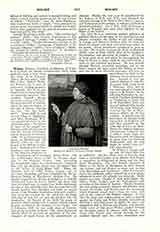

Wolfram von Eschenbach, generally regarded as the greatest of Middle-High-German epic poets, date of birth unknown; d. soon after 1216. Our scanty information about his life is derived mainly from his works. He was a Bavarian by birth. The town of Eschenbach, whence he gets his name, is a little southeast of Ansbach in Franconian territory. Though of noble birth, he was poor, possibly because he was a younger son. All that he owned was the small estate of Wihenberg (now Wehlenberg) near Ansbach. In his “Parzival” he speaks of the Count of Wertheim as Min Herre, whence it has been surmised that he was a vassal of that count. But the words in question may simply be an honorary title. Wolfram led a wandering life, and after 1203 stayed repeatedly at Eisenach at the Court of the landgrave Hermann of Thuringia. Parts of his “Parzival” were composed there. After the landgrave’s death (1217) the poet returned to his home. The date of his death is uncertain; he certainly survived the landgrave, whose death he alludes to in his poem “Willehalm”. He seems to have died soon after his patron) for his last works were left unfinished. He was buried in the Frauenkirche of Eschenbach, where his tomb was still to be seen in the seventeenth century.
Wolfram in his “Parzival” tells us explicitly that he could neither read nor write. His poems were written down from dictation. His knowledge was extensive and varied rather than accurate. He certainly knew French, but only imperfectly; for his proper names often show a curious misunderstanding of French words and phrases. He is the author of some lyric poems and three epics. The lyrics are mostly so-called Tagelieder (daysongs), in which lovers are exhorted to part by a watcher who announces the dawn. The poet’s fame however, rests on his epics, above all on his “Parzival”, the greatest of Middle High German court epics. It is the well-known story of the simpleton who passes through struggle and temptation and in the end wins the highest earthly happiness and becomes King of the Holy Grail. The poem consists of almost 25,000 verses and was composed between the years 1200 and 1216. As is the case with all Middle High German court epics, it is drawn from a French source. The precise relation of Wolfram’s poem to this source is a much mooted question. The most famous French poem on the subject of Parzival is the “Conte del Graal” of Chrestien de Troyes, composed possibly about 1180. Wolfram mentions this work, but cites as his source the work of a Provencal poet, Kyot (Guiot), to whom he gives the preference over Chrestien. But no such work is known, and hence some scholars have declared Kyot to be a fiction. But this seems to be going too far; today Kyot’s existence is generally admitted. Wolfram’s poem certainly contains much that is not found in the work of Chrestien, and which can hardly be explained as pure invention. Originally the Parzival story had an independent existence, being akin to the simpleton-tales familiar from folk-lore. But in Wolfram’s work, as before him in Chrestien’s, the story appears as part of the romances belonging to the Arthurian cycle; itis also connected with the legend of the Holy Grail.
It is acknowledged that, while Wolfram did not invent the story, he gave to it a deep spiritual meaning. In his “Parzival” the legend of the Holy Grail has found its highest and noblest poetic expression. The title “Titurel” is given to two fragments in strophic form, containing the love story of Sigune and Schionatulander, a mere episode in “Parzival”. The name is derived from Titurel, the ancestor of the Knights of the Grail, with whom the introductory strophes are concerned. A later poet treated the same subject at much greater length, and his work, “Der jiingere Titurel”, for a long time passed as Wolfram’s own. The poet’s last work was “Willehalm”. It relates the deeds of William of Orange against the Saracens. It is modeled on the French poem “Aliscans” with which Wolfram became acquainted through the landgrave Hermann. The work was left unfinished and was afterwards continued and expanded by Ulrich von Turheim and again by Ulrich von Turlin. The chief edition of Wolfram’s works is that of K. Lachmann (Berlin, 1833; 5th edition, 1891); an edition with explanation and commentary is that of K. Bartsch, “Parzifal and Titurel” in “Deutsche Klassiker des Mittelalters”, IX-XI, 3 parts (Leipzig, 1875-77); also edited by Paul Piper in Kürschner’s “Deutsche National-Litteratur”, V, 2 parts; and by E. Martin, “Parzival u. Titurel” (Halle, 1900-03), with commentary. A modernized German version of “Parzival” was given by K. Simrock (6th ed., 1883), G. Botticher (2nd ed., Berlin, 1893), W. Hertz (2nd ed., Stuttgart, 1904), and E. Engelmann (Stuttgart, 1888). An English version was made by Jessie Weston (London, 1894).
ARTHUR F. J. REMY

